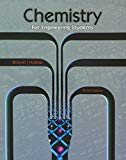
At what points in the Chapman cycle do photochemical reactions take place?
Interpretation:
The steps in the Chapman Cycle in which photochemical reactions occur should be identified.
Concept introduction:
➢ Ozone is being created and destroyed in the stratosphere.
➢ The chapman cycle involves photochemical reactions.
Answer to Problem 11.6PAE
Solution:
In the first step of the cycle a photochemical reaction takes place, the molecule oxygen absorbs energy from UV rays to produce 2 free radicals.
In the third step an ozone molecule absorbs some UV rays to produce a free radical and an oxygen molecule.
Explanation of Solution
Ozone and oxygen are in constant interaction with ultraviolet rays in the stratosphere, this process is called the “Chapman” cycle.
In the first step an oxygen molecule in presence with UV light with a wavelength less than 242 nm will be broken into 2 free radicals:
In a second step a free radical reacts with oxygen to form an ozone molecule:
In a third step an ozone molecule is broken into an oxygen molecule and a free radical in presence with uv light with a wavelength higher than 242 nm and lower than 320 nm.
In a fourth step an oxygen free radical reacts with an ozone molecule to generate 2 oxygen molecules
In the first step of the cycle a photochemical reaction takes place, the molecule oxygen absorbs energy from UV rays to produce 2 free radicals.
In the third step an ozone molecule absorbs some UV rays to produce a free radical and an oxygen molecule.
The chapman cycle absorbs UV rays turning them into heat.
Want to see more full solutions like this?
Chapter 11 Solutions
Bundle: Chemistry for Engineering Students, 3rd, Loose-Leaf + OWLv2 with QuickPrep 24-Months Printed Access Card
- What are the uses of Iodine in KFR? answer at your own words and answer should be to the point, not any irrelevant wordsarrow_forwardBorn-Haber cycle; I don’t know how to formulate it for this reaction.arrow_forwardCan the Nernst equation be used at temperatures other than room temperature?arrow_forward
- It is estimated that the net amount of carbon dioxide fixed by photosynthesis on the landmass of earth is 5.5*1016 g/yr of CO2. Assume that all this carbon is converted into glucose. Calculate the energy stored by photosynthesis on land per year, in KJ. Calculate the average rate of conversion of solar energy into plant energy in megawatts, MW. A large nuclear power plant produces about 103 MW. The energy of how many such nuclear power plants is equivalent to the solar energy conversion?arrow_forwardAside from reducing the use of fossil fuels and increasing the utilization of renewable forms of energy, propose one specific engineering intervention or solution that may slow down climate change. Describe, and illustrate if necessary, the details of how it works.arrow_forwardWhat is the net chemical reaction associated with the Chapman cycle?arrow_forward
- A new flame atomic-absorption spectroscopic method of determining antimony in the atmospherewas compared with the recommended calorimetric method. For samples from an urbanatmosphere the following results were obtained: follow up question: Do the results obtained by the two methods differ significantly?arrow_forwardGive an argument for why the pre-exponential factor is temperature dependent.arrow_forwardIt is estimated that the net amount of carbon dioxide fixed byphotosynthesis on the landmass of Earth is 5.5 x 1016 g/yrof CO2. Assume that all this carbon is converted into glucose.(a) Calculate the energy stored by photosynthesis onland per year, in kJ. (b) Calculate the average rate of conversionof solar energy into plant energy in megawatts, MW11W = 1 J/s2. A large nuclear power plant produces about103 MW. The energy of how many such nuclear power plantsis equivalent to the solar energy conversion?arrow_forward
- The average bond enthalpies of the C¬F and C¬Cl bonds are 485 kJ/mol and 328 kJ/mol, respectively. Given the fact that O2, N2, and O in the upper atmosphere absorb most of the light with wavelengths shorter than 240 nm, would you expect the photodissociation of C ¬ F bonds to be significant in the lower atmosphere?arrow_forwardLiterature suggests that much lower yields are observed for nitrate reduction versus oxygen respiration (about 2/3 of that for oxygen). However, your free energy-based calculation shows very similar yields in both scenarios assuming the same energy capture efficiencies. What do you think could be the possible reason?arrow_forwardDifferentiate between circumstances for the use of nRln(V2/V1) ??? Cvln(T2/T1) in calculating change in Sarrow_forward
 Chemistry for Engineering StudentsChemistryISBN:9781285199023Author:Lawrence S. Brown, Tom HolmePublisher:Cengage Learning
Chemistry for Engineering StudentsChemistryISBN:9781285199023Author:Lawrence S. Brown, Tom HolmePublisher:Cengage Learning
 Principles of Instrumental AnalysisChemistryISBN:9781305577213Author:Douglas A. Skoog, F. James Holler, Stanley R. CrouchPublisher:Cengage Learning
Principles of Instrumental AnalysisChemistryISBN:9781305577213Author:Douglas A. Skoog, F. James Holler, Stanley R. CrouchPublisher:Cengage Learning


